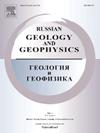阿尔加马金矿群(阿尔丹-斯坦诺沃伊盾):矿物学、形成条件、矿石物质来源和成矿年龄
IF 1
4区 地球科学
Q3 GEOSCIENCES, MULTIDISCIPLINARY
引用次数: 0
摘要
-本文介绍了位于阿尔丹地盾和斯坦诺沃伊地区交界处、研究较少的阿尔加马矿石群(博多罗诺矿床和迪沃克矿点)矿石形成条件的研究成果。我们已经确定,Bodorono 矿床的矿石中含有铋和硒矿物(铋石、锂辉石、原生铋、碲铋矿、四蝶铋矿、黑锂铋矿、铁锂铋矿和莱塔卡莱铋矿)。矿物形成分为两个连续的生产阶段:金多金属和金铋碲。相应的矿物是热液系统演变的产物,在这一过程中,流体温度(从 300 °C 降至 145 °C)和盐度(从 5 wt.% NaCl 当量降至 1.9 wt.% NaCl 当量)逐渐降低。原生金的细度从早期(约 840‰)到晚期(约 940‰)逐渐增加,并从简单硫化物向硫化物转变。伴随着矿石系统的演化,流体包裹体的气相成分也发生了变化,从 CH4-CO2 变为含有 N2 和 CH4 杂质的 CO2。前矿石变质岩的 40Ar/39Ar 测定结果表明,Bodorono 矿床的矿石形成过程大约发生在 150 ± 1.8 Ma.150 ± 1.8 Ma。方铅矿中铅的同位素组成分析表明,矿石物质的主要来源是古代地壳。计算得出的含矿石英中氧的同位素组成(δ18OH2O)在 1.0 至 7.3‰之间变化,与混合来源的水流相吻合。Dyvok 矿床与 Bodorono 矿床在矿石成分和矿石形成的物理化学参数方面有所不同。在该矿床中,已经确定了四个矿物阶段:金-砷黄铁矿-黄铁矿-石英、黄铁矿-黄铜矿-闪锌矿、石英-布兰杰石和碲化物。碲化物阶段以黑云母、白云母、volynskite、merenskyite、melonite 和 rucklidgeite 为代表。在中等温度(310-360 °C)下,含金矿化物形成于中等盐度的流体(0.9-9.2 wt.%氯化钠当量),气相中以二氧化碳为主,杂质为甲烷。δ34S和δ18O的计算值分别为2.2-3.0‰和0.6-12.0‰。金矿化的 40Ar/39Ar 年龄为 124.0 ± 1.5 Ma,与阿尔丹地盾的构造活动阶段相符。本文章由计算机程序翻译,如有差异,请以英文原文为准。
Algama Gold Ore Cluster (Aldan–Stanovoi Shield): Mineralogy, Formation Conditions, Sources of Ore Matter, and Age of Mineralization
—The paper presents results of research into the conditions of formation of ores in the poorly studied Algama ore cluster (Bodorono deposit and Dyvok ore occurrence) located at the junction of the Aldan Shield and the Stanovoi area. We have established that Bi and Se minerals (bismuthinite, lillianite, native bismuth, tellurobismuthite, tetradymite, hedleyite, pilsenite, and laitakarite) are present in the ores of the Bodorono deposit. Two successive productive stages of mineral formation have been distinguished: Au–polymetallic and Au–Bi–Te. The corresponding minerals are products of the evolution of a hydrothermal system, during which a gradual decrease in fluid temperature (from 300 to 145 °C) and salinity (from 5 to 1.9 wt.% NaCl equiv.) took place. The fineness of native gold gradually increases from early (~840‰) to late (~940‰) stages and changes in passing from simple sulfides to sulfosalts. The evolution of the ore system is accompanied by a change in the composition of the vapor phase of fluid inclusions from CH4–CO2 to CO2 with an impurity of N2 and CH4. The results of 40Ar/39Ar dating of pre-ore metasomatites point to ore-forming processes at the Bodorono deposit ca. 150 ± 1.8 Ma. Analysis of the isotopic composition of lead in galena shows the leading role of the ancient crustal source of ore matter. The calculated isotopic composition of oxygen (δ18OH2O) in ore-bearing quartz varies from 1.0 to 7.3‰, which corresponds to an aqueous fluid of a mixed source. The Dyvok ore occurrence differs from the Bodorono deposit in the mineral composition of ores and the physicochemical parameters of ore formation. Four mineral stages have been established within the ore occurrence: gold–arsenopyrite–pyrite–quartz, pyrite–chalcopyrite–sphalerite, quartz–boulangerite, and telluride. The telluride stage is represented by hessite, altaite, volynskite, merenskyite, melonite, and rucklidgeite. Gold-bearing mineralization formed from a fluid of medium salinity (0.9–9.2 wt.% NaCl equiv.) with a predominance of CO2 and an impurity of CH4 in the vapor phase at moderate temperatures (310–360 °C). The calculated values of δ34S and δ18O varied from 2.2 to 3.0‰ and from 0.6 to 12.0‰, respectively. The 40Ar/39Ar age of gold mineralization is 124.0 ± 1.5 Ma, which corresponds to the stage of tectonomagmatic activity in the Aldan Shield.
求助全文
通过发布文献求助,成功后即可免费获取论文全文。
去求助
来源期刊

Russian Geology and Geophysics
地学-地球科学综合
CiteScore
2.00
自引率
18.20%
发文量
95
审稿时长
4-8 weeks
期刊介绍:
The journal publishes original reports of theoretical and methodological nature in the fields of geology, geophysics, and geochemistry, which contain data on composition and structure of the Earth''s crust and mantle, describes processes of formation and general regularities of commercial mineral occurrences, investigations on development and application of geological-geophysical methods for their revealing. As to works of regional nature, accelerated publication are available for original papers on a variety of problems of comparative geology taking into account specific character of Siberia, adjacent Asian countries and water areas. The journal will also publish reviews, critical articles, chronicle of the most important scientific events, and advertisements.
 求助内容:
求助内容: 应助结果提醒方式:
应助结果提醒方式:


